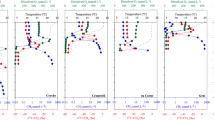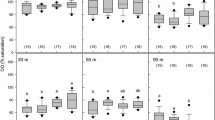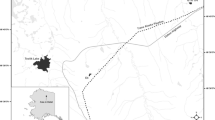Abstract
Large uncertainties exist regarding the influence of ongoing climate change to microbially mediated methane cycling in arctic lakes. Specifically, the coupled response of methanogenesis (MG) and methane oxidation (Mox) to increased temperature is poorly understood. Therefore, the effect of temperature on rates of sediment MG and water column Mox in two shallow Arctic Alaskan lakes were evaluated in 2010. To understand the capacity of Mox to offset potential increases in dissolved methane concentrations, kinetics of water column Mox were also determined. Rates of MG responded positively to increased temperature with a greater influence exerted at higher incubation temperatures. Substrate-saturated Mox significantly increased with temperature and was controlled by substrate and temperature interactions. In contrast, substrate-limited Mox was not influenced by temperature and was controlled by substrate supply. Analysis of Mox kinetics pointed to a community of water column dwelling methane oxidizing bacteria that are capable of oxidizing dissolved methane concentrations far in excess of observed levels. Assuming no diffusion limitation, our results suggest that Mox will likely offset increased MG in response to elevated temperature regimes as a function of ongoing climate change.




Similar content being viewed by others
References
Axford, Y., J. P. Briner, C. A. Cooke, D. R. Francis, N. Michelutti, G. H. Miller, J. P. Smol, E. K. Thomas, C. R. Wilson & A. P. Wolfe, 2009. Recent changes in a remote Arctic lake are unique within the past 200,000 years. Proceedings of the National Academy of Sciences 106(44): 18443–18446.
Bartlett, K. B., P. M. Crill, R. L. Sass, R. C. Harriss & N. B. Dise, 1992. Methane emissions from tundra environments in the Yukon-Kuskokwim Delta, Alaska. Journal of Geophysical Research 97(D15): 16645–16660.
Bastviken, D., J. Eljertsson, I. Sundh & L. Tranvik, 2003. Methane as a source of carbon and energy for lake pelagic food webs. Ecology 34(4): 969–981.
Bastviken D., J. Cole, M. Pace & L. Tranvik, 2004. Methane emissions from lakes: dependence of lake characteristics, two regional assessments, and a global estimate. Global Biogeochemical Cycles 18(4). doi:10.1029/2004GB002238.
Bender, M. & R. Conrad, 1992. Kinetics of CH4 oxidation in oxic soils exposed to ambient air or high CH4 mixing ratios. FEMS Microbiology Ecology 101: 261–270.
Borrell, G., D. Jezequel, C. Biderre-Petit, N. Morel-Desroisiers, J. Morel, P. Peyret, G. Fonty & A. Lehours, 2011. Production and consumption of methane in freshwater lake ecosystems. Research in Microbiology 162: 832–847.
Bowden, W. B., M. N. Gooseff, A. Balser, A. Green, B. J. Peterson & J. Bradford, 2008. Sediment and nutrient delivery from thermokarst features in the foothills of the North Slope. Potential impacts on headwater stream ecosystems, Alaska.
Buchholz, L. A., J. V. Klump, M. L. P. Collins, C. A. Brantner & C. C. Remsen, 1995. Activity of methanotrophic bacteria in Green Bay sediments. FEMS Microbiology Ecology 16: 1–8.
Carroll, M. L., J .R. G. Townshend, C. M. DiMiceli, T. Loboda & R. A. Sohlberg, 2011. Shrinking lakes of the Arctic: spatial relationships and trajectory of change. Geophysical Research Letters. doi:10.1029/2011GL049427.
Casper, P., 1996. Methane production in littoral and profundal sediments of an oligotrophic and a eutrophic lake. Archiv fur Hydrobiologie: Special Issues in Advanced Limnology 48: 253–259.
Casper, P., S. C. Maberly, G. H. Hall & B. J. Finlay, 2000. Fluxes of methane and carbon dioxide from a small productive lake to the atmosphere. Biogeochemistry 49: 1–19.
Dalton, H., 2005. The Leeuwenhoek lecture 2000. The natural and unnatural history of methane-oxidizing bacteria. Philosophical Transactions of the Royal Society 360: 1207–1222.
Daniels, L. & J. G. Zeikus, 1983. Convenient biological preparation of pure high specific activity 14C-labelled methane. Journal of radiolabeled compounds and radiopharmaceuticals 20: 17–24.
den Heyer, C. & J. Kalff, 1998. Organic matter mineralization rates in sediments: a within- and among-lake study. Limnology and Oceanograpy 43(3): 695–705.
Deutzmann, J. & B. Schink, 2011. Anaerobic oxidation of Lake Constance, and oligotrophic freshwater lake. Applied Environmental Microbiology 77(3): 4429–4436.
De Visscher, A., D. Thomas, P. Boeckx & O. Van Cleemput, 1999. Methane oxidation in simulated landfill cover soil environments. Environmental Science and Technology 33: 1854–1859.
De Visscher, A., M. Schippers & O. Van Cleemput, 2001. Short-term kinetic response of enhanced methane oxidation in landfill cover soils to environmental factors. Biology and Fertility of Soils 33: 231–237.
Dlugokencky, E. J., L. Bruhwiler, J. W. C. White, L. K. Emmons, P. C. Novelli, S. A. Montzka, K. A. Masarie, P. M. Lang, A. M. Crotwell, J. B. Miller & L. V. Gatti, 2009. Observational constraints on recent increases in the atmospheric burden. Geophysical Research Letters 36: L18803. doi:10.1029/2009GL039780.
Duc, N. T., P. Crill & D. Basviken, 2010. Implications of temperature and sediment characteristics on methane formation and oxidation in lake sediments. Biogeochemistry 100: 185–196.
Dunfield, P., R. Knowles, R. Dumont & T. R. Moore, 1993. Methane production and consumption in temperate and subarctic peat soils: response to temperature and pH. Soil Biology and Biochemistry 25: 321–326.
Einola, J. M., R. H. Kettunen & J. A. Rintala, 2007. Responses of methane oxidation to temperature and water content in cover soil of a boreal landfill. Soil Biology and Biochemistry 39: 1156–1164.
Frenzel, P., B. Thebrath & R. Conrad, 1990. Oxidation of methane in the oxic surface layer of a deep lake sediment (Lake Constance). FEMS Microbiology Ecology 73: 149–158.
Glissman, K., K.-J. Chin, P. Casper & R. Conrad, 2004. Methanogenic pathway and archaeal community structure in the sediment of eutrophic Lake Dagow: effect of temperature. Microbial Ecology 48: 389–399.
Grossert, H. P., K. Frindte, C. Dzialles, W. Eckert & K. W. Tang, 2011. Microbial methane production in oxygenated water column of an oligotrophic lake. Proceedings of the National Academy of Sciences 108(49): 19657–19661.
Hamilton, T. D, 2003. Glacial geology of the Toolik Lake and Upper Kuparuk River region, University of Alaska Fairbanks, Institute of Arctic Biology, Biological Papers of the University of Alaska, Fairbanks, Alaska.
Hanson, R. S. & T. E. Hanson, 1996. Methanotrophic bacteria. Microbiological Reviews 60(2): 439–471.
Harrits, S. M. & R. S. Hanson, 1980. Stratification of aerobic methane-oxidizing organisms in Lake Mendota, Madison, Wisconsin. Limnology and Oceanography 25(3): 413–421.
He, R., M. J. Wooler, J. W. Pohlman, J. Quensen, J. M. Tiedje & M. B. Leigh, 2012. Shifts in identify and activity of methanotrophs in Arctic lake sediments in response to changes. Applied and Environmental Microbiology 78(13): 4715–4723.
Isaksen I. S. A., M. Gauss, G. Myhre, K. M. Walter Antony & C. Ruppel, 2011. Strong atmospheric chemistry feedback to climate warming from Arctic methane emissions. Global Biogeochemical Cycles 25: GB2002. doi:10.1029/2010GB003845.
Kankaala, P., J. Juotari, E. Peltomaa, T. Saloranta & A. Ojala, 2006. Methanotrophic activity in relation to methane efflux and total heterotrophic bacterial production in a stratified, humic, boreal lake. Limnology and Oceanography 51(2): 1195–1204.
Kankaala, P., S. Taipale, H. Nykanen & R. I. Jones, 2007. Oxidation, efflux, and isotopic fractionation during autumnal turnover in a polyhumic, boreal lake. Journal of Geophysical Research 112: G02003. doi:10.1029/2006JG000336.
Karllson, J., R. R. Christensen, P. Crill, J. Forster, D. Hammarlund, M. Jackowicz-Korczynski, U. Kokfelt, C. Roehm & P. Rosen, 2010. Quantifying the relative importance of lake emissions in the carbon budget of a subarctic catchment. Journal of Geophysical Research 115: G03006. doi:10.1029/2010JG001305.
Kelly, C. A. & D. P. Chynoweth, 1981. The contributions of temperature and the input of organic matter in controlling rates of sediment methanogenesis. Limnology and Oceanography 26(5): 891–897.
King, G. M., 1992. Ecological aspects of methane consumption, a key determinant of global methane dynamics. Advances in Microbial Ecology 12: 431–468.
King, G. K. & A. P. S. Adamsen, 1992. Effects of temperature on methane consumption in a forest soil and in pure cultures of the methanotroph Methylomonas rubra. Applied and Environmental Microbiology 58(9): 2758–2763.
Kling, G. W, 1995. Land-water linkages: the influence of terrestrial diversity on aquatic systems. 297–310. In Chapin, F. S. & Korner C. (eds), The Role of Biodiversity in Arctic and Alpine Tundra Ecosystems. Springer, Berlin: 320 pp.
Knief, C. & P. F. Dunfield, 2005. Response and adaptation of different methanotrophic bacteria to low methane mixing ratios. Environmental Microbiology 7(9): 1307–1317.
Kuivila, K. M., J. W. Murray, A. H. Devol, M. E. Lidstrom & C. E. Reimers, 1988. Methane cycling in the sediments of Lake Washington. Limnology and Oceanography 33(4): 571–581.
Lehninger A., 2000. Principles of Biochemistry, 3rd edn by Nelson D. L. & M. M. Cox (eds) Worth Publishers, New York.
Liikanen, A., J. T. Huttunen, K. Valli & P. J. Martikainen, 2002. Methane cycling in the sediment and water column of mid-boreal hyper-eutrophic Lake Kevaton, Finland. Archiv Fur Hydrobiologie 154(4): 585–603.
Mazéas, O., J. C. von Fischer & R. C. Rhew, 2009. Impact of terrestrial carbon input on methane emissions from an Arctic Alaskan lake. Geophysical Research Letters 36: L18501. doi:10.1029/2009GL039861.
Mueller, D. R., P. Van Hove, D. Antoniades, M. O. Jeffries & W. F. Vincent, 2009. High Arctic lakes as sentinel ecosystems: Cascading regime shifts in climate, ice cover, and mixing. Limnology and Oceanography 54(6, part 2): 2371–2385.
Nusslein, B. & R. Conrad, 2000. Methane production in eutrophic Lake Plubsee: seasonal change, temperature effect and metabolic processes in the profundal sediment. Archiv fur Hydrobiologie 149(4): 597–623.
Nozhevnikova, A. N., C. Holliger, A. Ammann & A. J. B. Zehnder, 1997. Methanogenesis in sediments from deep lakes at different temperatures (2–70°C). Water Science and Technology 36(6–7): 57–64.
Nozhevnikova, A. N., V. Nekrasova, A. Ammann, A. J. B. Zehnder, B. Wehril & C. Holliger, 2007. Influence of temperature and high acetate concentrations on methanogenesis in lake sediment slurries. FEMS Microbiology Ecology 62: 336–344.
Ping, C. L., J. G. Bockheim, J. M. Kimble, G. J. Michaelson & D. A. Walker, 1998. Characteristics of cryogenic soils along a latitudinal transect in Arctic Alaska. Journal of Geophysical Research 103: 28917–28928.
Post, E., M. C. Forchhammer, M. S. Bret-Harte, T. V. Callaghan, T. R. Christensen, B. Elberling, A. D. Fox, O. Gilg, D. S. Hik, T. T. Hoye, R. A. Ims, E. Jeppesen, D. R. Klein, J. Madsen, A. D. McGuire, S. Rysgaard, D. E. Schindler, I. Stirling, M. P. Tamstorf, N. J. C. Tyler, R. van der Wal, J. Welker, P. A. Wookey, N. M. Schmidt & P. Aastrup, 2009. Ecological dynamics across the Arctic associated with recent climate change. Science 325: 1355–1358.
Rahalkar, M. & B. Schink, 2007. Comparison of aerobic methanotrophic communities in littoral and profundal sediments of Lake Constance by a molecular approach. Applied and Environmental Microbiology 73(13): 4389–4394.
Remsen, C. C., E. C. Minnich, R. S. Stephens, L. Buchholz & M. E. Lidstrom, 1989. Methane oxidation in Lake Superior sediments. Journal of Great Lakes Research 15(1): 141–146.
Robinson, J. A., 1985. Determining microbial kinetic parameters using nonlinear regression analysis. Advantages and limitations in microbial ecology. Advances in Microbial Ecology 8: 61–114.
Roslev, P., N. Iversen & K. Henriksen, 1997. Oxidation and assimilation of atmospheric methane by soil methane oxidizers. Applied and Environmental Microbiology 63(3): 874–880.
Rudd, J. W. & R. D. Hamilton, 1975. Factors controlling rates of methane oxidation and the distribution of the methane oxidizers in a small stratified lake. Archiv fur Hydrobiologie 75: 522–538.
Schulz, S. & R. Conrad, 1996. Influence of temperature on pathways to methane production in the permanently cold profundal sediment of Lake Constance. FEMS Microbiology Ecology 20: 1–14.
Schulz, S., H. Matsuyama & R. Conrad, 1997. Temperature dependence of methane production from different precursors in a profundal sediment (Lake Constance). FEMS Microbiology Ecology 22: 207–213.
Segers, R., 1998. Methane production and methane consumption: a review of processes underlying wetland methane fluxes. Biogeochemistry 41: 23–51.
Semiltov, I. P., 1999. Aquatic sources and sinks of CO2 and CH4 in the polar regions. Journal of the Atmospheric Sciences 56: 286–306.
Sokal, R. R. & F. J. Rohlf, 1995. Biometry, 3rd ed. W.H. Freeman and Company, New York.
Stolaroff, J. K., S. Bhattacharyya, C. A. Smith, W. L. Bourcier, P. J. Cameron-Smith & R. D. Aines, 2012. Review of methane mitigation technologies with application to rapid release of methane from the Arctic. Environmental Science and Technology 46: 6455–6469.
Stumm, W. & J.J. Morgan. 1996, Aquatic Chemistry: Chemical Equilibria and Rates in Natural Waters. Wiley, New York: 1022 pp.
Sundh, I., D. Bastviken & L. J. Tranvik, 2005. Abundance, activity, and community structure of pelagic methane-oxidizing bacteria in temperate lakes. Applied and Environmental Microbiology 71(11): 6746–6752.
Thebrath, B., F. Rothfuss, M. J. Whiticar & R. Conrad, 1993. Methane production in littoral sediment of Lake Constance. FEMS Microbiology Ecology 102: 279–289.
Valentine, D. & W. Reeburgh, 2000. New perspectives on anaerobic methane oxidation. Environmental Microbiology 2(5): 477–484.
Walter, K. M., L. C. Smith & F. S. Chapin III, 2007. Methane bubbling from northern lakes: present and future contributions to the global methane budget. Philosophical Transactions of the Royal Society 365: 1657–1676.
Wetzel, R. G., 2001. Limnology: lake and river ecosystems, 3rd ed. Academic Press, New York.
Whalen, S. C., 2005. Biogeochemistry of methane exchange between natural wetlands and the atmosphere. Environmental Engineering Science 22(1): 2005.
Whalen, S. C. & J. C. Cornwell, 1985. Nitrogen, phosphorous, and organic carbon cycling in an arctic lakes. Journal of Fisheries and Aquatic Sciences 42: 794–808.
Whalen, S. C. & W. S. Reeburgh, 1996. Moisture and temperature sensitivity of CH4 oxidation in boreal soils. Soil Biology and Biochemistry 28(10/11): 1271–1281.
Whalen, S. C., B. A. Chalfant & E. N. Fischer, 2008. Epipelic and pelagic primary production in Alaskan Arctic lakes of varying depth. Hydrobiologia 614: 243–257.
Yamamoto, S., J. B. Alcauskas & T. E. Crozier, 1976. Solubility of methane in distilled water and seawater. Journal of Chemical and Engineering Data 21(1): 78–80.
Zar, J. H., 1996. Biostatistical Analysis, 3rd ed. Prentice Hall, Inc., Upper Saddle River, NJ.
Zeikus, J. G. & M. R. Winfrey, 1976. Temperature limitation of methanogenesis in aquatic sediments. Applied and Environmental Microbiology 31(1): 99–107.
Zinder, S. H., 1993. Physiological Ecology of Methanogens. In Ferry, J. G. (ed.), MG: Ecology Biochemistry Physiology and Genetics. Chapman and Hall, New York, NY: 129–206.
Acknowledgments
We would like to thank Gabe McGowan and Kristen Bretz for field and lab assistance as well as the Toolik Field Station Staff for logistical support. This work was funded by NSF Grants 0807094 and 0516043. We would also like to thank two anonymous reviewers for their valuable input that improved this manuscript.
Author information
Authors and Affiliations
Corresponding author
Additional information
Handling editor: Mariana Meerhoff
Rights and permissions
About this article
Cite this article
Lofton, D.D., Whalen, S.C. & Hershey, A.E. Effect of temperature on methane dynamics and evaluation of methane oxidation kinetics in shallow Arctic Alaskan lakes. Hydrobiologia 721, 209–222 (2014). https://doi.org/10.1007/s10750-013-1663-x
Received:
Revised:
Accepted:
Published:
Issue Date:
DOI: https://doi.org/10.1007/s10750-013-1663-x




